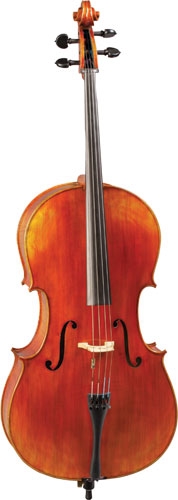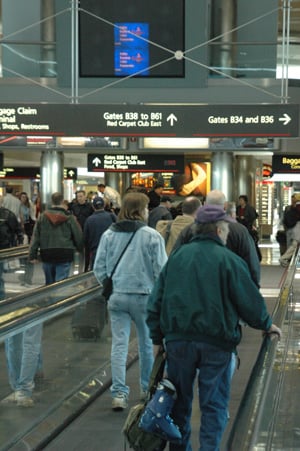 If you’re an active musician, chances are you’ll be traveling to a gig, performance or audition out of town. If you’re a violinist or flutist, this isn’t a big deal... well, at least it shouldn't be. But if you’re a cellist or bassist? Let’s just say that if you play either of these instruments, traveling with them can be a pain in the neck. (And hopefully not your cello’s neck!) But if you heed some of the following advice and carefully plan ahead, hopefully you can avoid having too many problems.
If you’re an active musician, chances are you’ll be traveling to a gig, performance or audition out of town. If you’re a violinist or flutist, this isn’t a big deal... well, at least it shouldn't be. But if you’re a cellist or bassist? Let’s just say that if you play either of these instruments, traveling with them can be a pain in the neck. (And hopefully not your cello’s neck!) But if you heed some of the following advice and carefully plan ahead, hopefully you can avoid having too many problems.
Purchasing a Cello Case
If you’re going to be traveling, we recommend you purchasing a case that has a hard outer shell made from a durable material. You will also want to consider how much you’d like your case to weigh as well as cost. It will be important to have a reasonably lightweight case, because if you’re going to traveling and walking a lot, you won’t want to have a really heavy case to lug around. It’s important to balance durability and portability, making sure you don’t sacrifice one for the other. You’ll probably also want the option for good backpack straps and/or wheels. You will also want to make sure the case has easy-to-open latches, not zippers, when possible. This will make it easier for you to open & close your case for airport security. Temperature and humidity are also a concern. You’ll want a case that has insulation and helps you control the temperature and humidity conditions as best you can.
So, what are some good cello case options?
For those on a tighter budget but who need more protection than a padded bag, the Cushy® Hard Body Cello Case or Heritage® Mobile Lightweight Cello Case can offer significant protection from bumps, drops, and pressure. However, these are ideal only for situations where the cello is at no risk of being stacked or squished! if the cello is to be put in a storage compartment such as on a coach bus or luggage cart, a harder shell is mandatory, like the affordable but very protective Mobile Cello Case.
If you have the budget for it, we’d highly recommend that you consider an SL1000, SL500, or Bam cello case. These cases are well-built and known for their durability, strength and lightweight options. There are a few different BAM cello case options, but we would recommend the Newtech or the Hightech. The “Newtech” costs more than other cases, but its outside shell is a double layered structure. This means it has two layers: the ABS (Acrylonitrile Butadiene Styrene) outer layer with an anti-scratch PMMA film. The Newtech is fairly lightweight. Finally, there is the Bam Hightech case, which has a three layer outside shell, which is supposed to make it the most protective and the lightest weighing option. The Hightech is significantly more expensive, but it is extremely lightweight.
Carbon fiber is also a good material for lightweight cello cases, but not in a pure form. Here at SHAR, we manufacture our own cello case called the SL1000 Cello Case. It’s exceptionally lightweight and protective, comes in several attractive colors, and uses an ideal blend of carbon fiber and polymer materials. Because the carbon fiber shell is made under much higher temperature and pressure than most carbon fiber cases, the shell is strong and stiff, even when opened and standing upright, which every cellist can appreciate. This case can accommodate most cello patterns, but is also available for Montagnana cellos.
Flying with Your Cello
 The cello case options mentioned above will definitely withstand a lot of walking around and traveling by car. But what if you have to fly somewhere with your cello? You will want to consider getting a dedicated cello “flight case.”
The cello case options mentioned above will definitely withstand a lot of walking around and traveling by car. But what if you have to fly somewhere with your cello? You will want to consider getting a dedicated cello “flight case.”
There are a couple options:
1. You could either purchase a flight case that’s intended to protect your instrument if you check it, or you could purchase a cello case flight cover. If you purchase a flight case, it will likely be really heavy but that’s because it’s meant to withstand the rigors of touring, rough handling, and being checked underneath the plane (with the passenger luggage). They’re usually made from durable Kevlar and fiberglass.
Pros: You won’t have to buy an extra seat or deal with the hassle with the airline.
Cons: No case will ever fully protect or 100% guarantee against super rough handling by an airline employee, and you might worry that the cello will be in one piece when it arrives at its destination. Also they can be costly.
2. If you’re going to choose to fly with your cello and you own a Bam case, there is an option now to cover your cello case with a Bam cello case flight cover in order to protect it when it’s checked as baggage. This flight case cover is a thick cordura cover with approximately 2 inches of insulating polyurethane foam. This is an indispensable addition to the Bam cello case for travel. The cover is molded to fit most Bam cases (Light, Flight, American, Shuttle, Voyager and Newtech models). The cover may fit other brands of cello cases but we cannot recommend its efficiency when used with non-Bam cases. If you end up purchasing one of these Bam case flight covers, here’s a little trick we found on the Bam website: “Fit the cello case, head first in the Flight Cover, zip around the head, adjust the bottom of the case inside the Flight Cover and zip around the bottom part, the zipper pulls meet in the middle.”
Pros: Very protective. You won’t have to buy an extra seat or deal with the airline. More affordable than a “flight case.”
Cons: No case or case cover can ever fully protect against super rough handling or bouncing in checked baggage, and temperature could also be a concern if you’re checking your instrument.
Should You Even Travel by Plane?
 The bonuses of air travel is pretty obvious: you’ll get to your destination as quickly as possible, so you can be well rested and ready for your performance or audition. The downside? Well, it can get complicated when you’re traveling with such a large instrument. Here are some things you'll want to consider:
The bonuses of air travel is pretty obvious: you’ll get to your destination as quickly as possible, so you can be well rested and ready for your performance or audition. The downside? Well, it can get complicated when you’re traveling with such a large instrument. Here are some things you'll want to consider:
1. Research the airline you’re flying, make sure you know their rules and comply by them. Be sure to print (or have with you on a device), so that you can show it to the airline employees, who might not be aware of the policy. One complication: even if you purchase your ticket through an American-based airline, if a subsidiary codesharing airline is operating your flight, they may not be obligated to follow their parent airline’s policies. If you are unsure, call the airline and speak to someone, rather than assume things when buying your flight on a website.Protect your investment the best way you can, by buying a good case or flight case or case cover.
2. Check the baggage rules carefully. Sometimes additional fees are necessary. Other times, they may not let you check a cello or bass with an external case cover. It just depends on the rules (which sometimes change, making it more complicated). Be aware that if you check your instrument as baggage, that it will go underneath the plane and be subjected to very cold temperatures. Your cello or bass could sustain damage or have other issues due to the temperature change.
3. Be aware of the TSA and their policies and procedures. The TSA has opened up cello cases in the past for baggage checks and does not necessarily handle the instrument the way a player would. There are horror stories about broken bows and cracked instruments; there are stories about checked-in cellos not making it to the connecting flight’s cargo and the airline losing the cello.
4. Check out the rules of FAA (if you’re flying domestically) and be sure to print and have it with you, in case you encounter problems.
5. Be aware and check out the rules/laws about cellos on flights in another country. International travel might mean you’re dealing with different laws. Many materials are banned from traveling between countries, including Ivory, Tortoise Shell, and many other materials that could be part of your bow or instrument - some bows like the Klaus Becker World Bows were made to avoid trouble at customs. Most countries in the EU should allow cello travel, but double check to be sure. Canadian-based airlines don’t have to abide by FAA rules of American law (even if you’re boarding a flight headed to the US). If you’re traveling overseas to other countries that might have different policies than ours, it might even be wise to bring proof of ownership of your cello in case any officials or customs give you a hard time when trying to travel with your instrument.
6. Allow extra time! The amount of time you give yourself to travel to your destination can make or break your performance or audition experience. Allow time for potential arguments with an airline or TSA agent if you intend to take your cello on the plane. Allow extra time in case you get bumped off of a flight (not unheard of, especially when a flight is oversold and they consider your cello merely as cargo, despite having bought a seat for it). There have been situations where musicians get bumped or end up having to go with a plan B for travel, such as renting a car and driving to the destination, so you’ll want to book dates accordingly to allow time for potential issues.
What about the Train?
 When traveling by train, you’ll likely have a good experience with carrying your cello. It’s generally less hassle, but it’s common to have to purchase an additional seat for your cello (or any oversized instrument, such as a bass or tuba). Amtrak states on their website: “Oversize instruments may only be carried onboard with the purchase of an additional full revenue seat – no larger than 72”/1829 mm in height.” The downside, of course, is that Amtrrak is notorious for long delays and traveling by train in the U.S. is proably second only to biking as far as time spent in transit.
When traveling by train, you’ll likely have a good experience with carrying your cello. It’s generally less hassle, but it’s common to have to purchase an additional seat for your cello (or any oversized instrument, such as a bass or tuba). Amtrak states on their website: “Oversize instruments may only be carried onboard with the purchase of an additional full revenue seat – no larger than 72”/1829 mm in height.” The downside, of course, is that Amtrrak is notorious for long delays and traveling by train in the U.S. is proably second only to biking as far as time spent in transit.
What about Renting a Car?
This option is definitely the easiest one for cellists, because you’ll experience the least amount of hassle (no airline employees to deal with): you can keep your cello safe and you can control its climate. Obviously, it isn’t ideal because it can take a long time and is potentially very costly. It also obviously won't work for a gig overseas!
Switch to the Flute?
There are a lot of ways to travel and a lot of options for cases to make it easier. Each player will have to weigh the risks and benefits and make their own decision accordingly. Unless you switch to playing the flute, there's no doubt you will encounter your share of headaches when you try to travel with a delicate and expensive instrument. That doesn't mean you can't be as prepared as possible though, and we hope you'll benefit from this advice when you travel to gigs and auditions!


